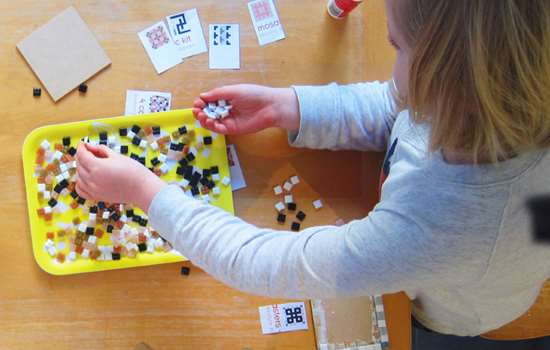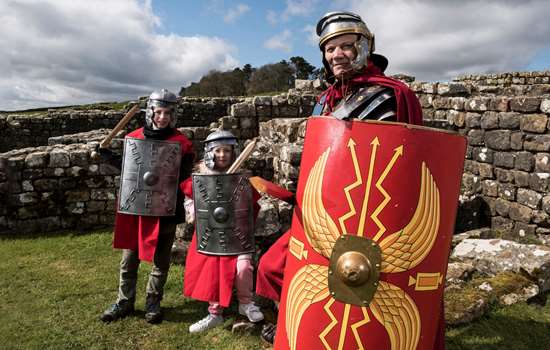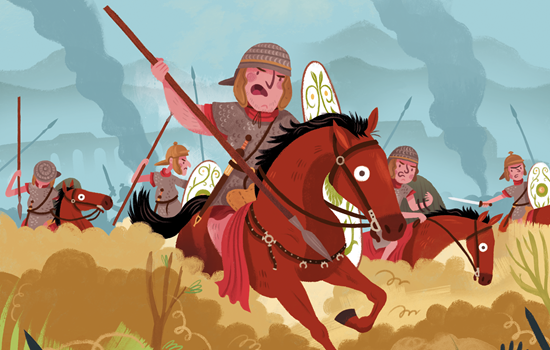Learn to draw Emperor Hadrian with Kids Rule! magazine illustrator Wesley Robins! Have a piece of paper and a pen or pencil ready, and draw along with Wesley, as he shows you step-by-step how to portray this Roman emperor. Then, add your own finishing touches using coloured pencils, pens or paints.
We'd love to see your finished artwork and we'll share our favourites in a gallery on this page. Make sure you have your parent or guardian's permission to email it to us at members.magazine@english-heritage.org.uk, along with your name and age.
About Emperor Hadrian
- Born: 24 January AD 76, Rome
- Became Roman emperor: AD 117
- Most famous for: ordering the building of Hadrian’s Wall
- Died: 10 July AD 138, Naples
- Succeeded by: Antoninus Pius, Hadrian’s adopted son and named heir
Hadrian was actually named Publius Aelius Traianus Hadrianus Augustus. He was born in Rome, but his family were from ltalica in the Roman province of Hispania (Spain). Hadrian’s father died when he was only 10 years old, so Hadrian was looked after by his father’s cousin, the future emperor Trajan.
Hadrian gained lots of military experience as a legatus (general) during the conquests of Dacia (modern-day Romania) and later Parthia (Iraq). He served as consul to the Roman state – an important role of the highest honour – and had two terms as a governor of provinces of the Roman Empire.
Becoming Emperor
When Trajan died in AD 117, he hadn’t named a successor. Hadrian’s military experience and closeness to Trajan meant that he was in a good position to become the next emperor. The day after Trajan’s death it was announced that Hadrian had been adopted as his son and heir before the emperor’s death, although there were rumours that Hadrian’s supporters had made this up. When the army recognised Hadrian as emperor, the Roman senate also accepted his rule, however four senators that were against Hadrian becoming emperor were executed.
As a new emperor, Hadrian implemented policies in Rome that were designed to help him become a popular ruler. He cleared the debts of citizens, paid for games and shows and handed money to the people.
Hadrian was very interested in Greek culture, and when he was a boy, this earned him a nickname: Graeculus (meaning ‘little Greek). Although it had been conquered by Rome, Greece had a strong influence on Roman culture. Hadrian spent a year there, adding new public buildings in Athens, including a new library and aqueduct, he finished the temple of Zeus (a Greek God), and he also participated in religious festivals and rituals.
Building Hadrian's Wall
When Hadrian inherited the Roman Empire, it had been continually expanding for hundreds of years. It was struggling to keep new lands, and people were rebelling against Roman rule. Therefore, Hadrian decided to improve security and stability within the empire, rather than trying to expand it. He gave up some lands in Dacia and Parthia, and made plans to review his army and strengthen borders along the edges of the empire.
Hadrian visited Britain in AD 122. We don’t know exactly why the wall was started, but there is some evidence which suggests that the people of Britain were revolting against the empire and that Hadrian came to suppress this. Hadrian’s Wall fits in with his plans to strengthen the frontiers of the empire – in a grand and elaborate way!
After visiting Britain, Hadrian toured the rest of his empire. He went to Spain then to Asia, the Greek Islands, Athens, Sicily and finally back to Rome. Hadrian travelled a lot while he was emperor, and he also did long tours of Africa and Mauretania.
Discover more about Hadrian's WallAntinous
Hadrian was married to Trajan's great-niece Sabina Augusta, but he also had relationships with men. Many Roman men, including emperors, had relationships with both men and women.
The most famous of Hadrian’s male partners was a man called Antinous. He travelled with Hadrian and his wife, including a visit to Egypt, where they saw the tombs of Alexander the Great and enjoyed hunting together. But tragedy struck, and Antinous drowned whilst sailing down the Nile in October AD 130. He was only around 20 years old.
Hadrian commemorated his death by building a new city called Antinoöpolis, and had statues of Antinous put up throughout the empire. Hadrian also had Antinous worshipped as a god, which was very unusual for anyone who was not a member of the imperial family. His cult became very popular, and more images of Antinous survive today than any other Roman figure, apart from Emperor Augustus, and Hadrian.
A lasting legacy
Hadrian died of heart disease at Baiae (on the gulf of Naples) on 10 July AD 138. He had a long reign that had a big impact on the culture and frontier borders of the Roman Empire.
In Britain, Hadrian’s Wall was mostly abandoned by Hadrian’s successor Antoninus Pius, in favour of a new one further north called the Antonine Wall, which was built between the Firth of Forth and the Firth of Clyde (in today’s Scotland). However, this wall was abandoned after Antoninus died, and Hadrian’s Wall was refurbished and reoccupied in the AD 160s. It marked the frontier of Roman Britain for 250 more years and has stood as Hadrian’s physical legacy for 1,900 years, with visitors coming from all over the world.
Visit Hadrian's WallYou did it!
We love seeing your brilliant drawings of Emperor Hadrian – here are some of our favourites!
Learn more about the Romans
Explore our Kids Rule! guide to Roman England to find out about the Roman Conquest, Hadrian's Wall and what life was like in Roman England. Discover a day in the life of people in the past, meet a legionary and get hands-on in the kitchen to make your own Roman burgers!
Plus: videos to watch, crafty how-to guides, quizzes to test your knowledge and read Kids Rule! magazines online.
Explore Roman England



